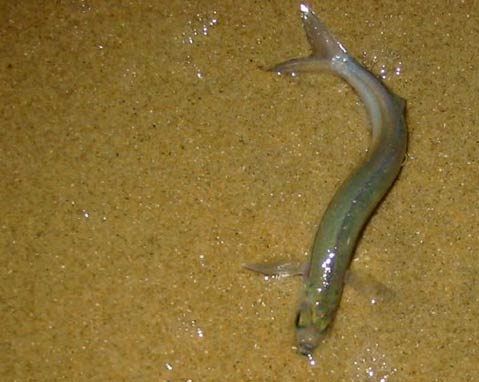Running with the Grunion
The Fish That Strives to Be Out of Water

Late some summer nights along certain southern California beaches, an amazing phenomenon of nature can be witnessed: fish flopping out of water, but of their own volition.
This behavior of the grunion, which makes its way up onto the beach to spawn, has long captivated (and fed!) onlookers. But what has made the grunion so well known is not only that they completely leave ocean waters to spawn, but that they do so in such a synchronized manner, sometimes causing thousands to cover a single beach at one time.
They’re the only fish known to accomplish such an astonishing feat. To protect them during this vulnerable spawning time, California has declared it closed season to hunt them during peak spawning months, and at other times a fishing license is required. What is possibly more impressive, yet less acknowledged, is that while the adults are out of water for a only few minutes to spawn, the resultant fish embryos remain on the land for nearly two weeks.
Grunion (the genus Leuresthes) belong to the Atherinopsidae family of neotropical silversides, which are mostly small, silver-colored fish that live in marine and freshwaters of the Americas. Grunion are only found along the Southern California coast and the coast around the Baja California peninsula in Mexico. There are two grunion species: the California grunion (L. tenuis), which lives on the Pacific coast from Point Conception to the tip of the Baja California peninsula (in nearshore waters no deeper than 60 feet), and the Gulf grunion (L. sardinas), which lives in the Gulf of California. Besides location, perhaps the biggest difference between the species is that the Gulf grunion spawns during day and night, while the California grunion only spawns at night.
Although grunion were not thought to typically travel further north than Point Conception, some have been found spawning as far north as the San Francisco Bay during the last decade; researchers theorize this is because fish traveled north with the warmer waters of the late 1990s (due to El Niño).
Many residents of southern California are well-aware of grunion “runs.” A “run” refers to the fact that the fish arrive at a particular place at a certain time, in a synchronized fashion, to spawn. Around 90 percent of the grunion runs take place on beaches in Los Angeles, Orange, and San Diego counties, although favored beaches can change from year to year. Most spawning occurs between March and August (sometimes as early as February and as late as September), with peak spawning months being April to June.
However, the exact nights of the runs correspond to the cycle of the moon and resultant tides.
Because they are so closely linked to the phases of the moon, grunion run schedules can be made years in advance. The highest high tides of the year occur with the new or full moon, around every two weeks (these are called the spring tides), and grunion runs are predicted to take place the following nights. For example, the next new moon is April 14; the grunion are scheduled to make runs on the nights of April 14 through April 17, although the best runs are thought to occur on the second and third nights (April 15 and 16). While the number of grunion that will show is difficult to predict, grunion run schedules can be narrowed down to a range of a couple hours on these nights. For a current grunion run schedule, visit the California Department of Fish and Game website on California Grunion Facts and Runs.
As the highest tides start to retreat, the grunion swim ashore in the remaining large waves to lay their eggs. Beginning with just a few of the five- to six-inch long fish, beaches can quickly become covered by thousands of grunion. High up on the beach, a female grunion will use her tail to dig herself into the sand, so that she’s covered up to her head, and lay her eggs. The larger, more mature grunion females can lay up to 3,000 eggs at one time! The males make their way to a female, who is chosen more for the suitability of the site she picked than any qualities of the female herself. While some males may wrap themselves around the female, other males do not; but all interested males will deposit their milt (the fish equivalent to sperm) to fertilize the eggs in the pit below.
During this frenzy, the grunion make grunting sounds for which they are named (originally “gruñón” in Spanish). After the males return to the sea, the female wriggles out of her hole and also glides back to the ocean. A given grunion will spawn repeatedly over the season. Although this whole encounter is astonishingly fast (each grunion normally takes less than three minutes to do its business), a run can last several hours.
But what exactly happened in that three-minute stand? Researchers have long observed that as many as eight males interact with a single female, although it was unclear how many of these males were actually successful in fertilizing the female’s eggs. In 2009, Rosemary J. Byrne and John C. Avise at the University of California, Irvine reported that most grunion nests do indeed have multiple fathers, according to their genetics studies. More interestingly, some nests had eggs that were fertilized by more males than were seen at the nest during spawning, revealing that nests are fertilized by males that aren’t even present at the time of spawning. Researchers theorize that the “extra” milt could have come from multiple sources: a male that was in the same area but at a different time, a nearby nest that had milt washed from it to the nest in question, or a nearby male that was not directly taking part in the action at the nest, but spreading his milt in what the scientists termed a “shotgun-released” manner.
So why do the grunion care about the tides? It turns out it’s very important for them to get the timing just right to ensure that their beach-bound eggs survive. After the “love fest” is over, the eggs are left to develop and fend for themselves. The receding tides that follow the runs leave more sand on the beach, helping protect the newly deposited eggs. While the top sand can become dry, just a few inches deeper, the sand around the eggs is still moist. The relatively warmer temperature and higher levels of oxygen in the sand may help improve the eggs’ development. After about 10 days of incubating in the sand, the eggs feel the swish of water from the next high, spring tide. This agitation stimulates the eggs to hatch. Although the adult grunion’s ability to become temporarily terrestrial is quite impressive (surviving up to an hour out of water when accidentally stranded), even more extraordinary is the ability of the eggs to survive in the sand for 10 days.
Just like the spawning, the hatching of the eggs is synchronous: All the grunion eggs on a beach hatch in just a few minutes, and are then carried out to the ocean on the high tide waves. Amazingly, the grunion can develop and be alert in their eggs, but delay hatching if, for some reason, the right environmental stimulus does not occur. They are the only fish known to do this. The newly hatched grunion remain by the shore for about 40 days and then swim to deeper waters. After a year, the grunion are mature and can take part in the runs themselves over their two- to four-year lifespan.
While grunion are the only fish known to perform beach spawning in a synchronized manner, several other fish independently evolved the ability to use the beach for mating and egg-sitting. Some prickle back fish (genus Xiphister) can be out of the water on the beach for up to 13 hours, and deposit their eggs there too. The midshipman (Porichthys notatus), like the grunion, spawns on the beach during high tide, but, unlike the grunion, these fish remain on the beach when the tide recedes to protect their egg clutches. Other fish do not invest as much energy in their young: The white stickleback (genus Gasterosteus) lays eggs on the beach during high tide, but then abandons them (like the grunion do).
While the ability of these fish to lay eggs on the beaches is impressive, they cannot compare with the synchronicity with which the grunion carries out this same duty. One fish that comes close is a smelt known as the capelin (Mallotus villosus). Two males and one female capelin will come ashore on a wave assisted by high winds. All within 30 seconds, the males dig a hole into which the female lays adhesive eggs, and then they’re all carried out to the ocean on the next wave. But this display significantly takes its toll on the fish; there are often very high mortality rates after spawning.
The mortality of the California grunion during spawning is strongly dependent on predators, e.g. people. For millennia, grunion have been an important part of Native Americans’ local diet. Small schooling fish, including the California grunion, make up approximately half of all marine fish remains found in Native American archaeological sites on the central California coast dating as far back as 6200 B.C. However, to protect grunion during their vulnerable spawning, in 1947 it was declared closed season for grunion during April through May, their peak spawning months. During these months it is still illegal to catch the grunion, although it is a perfect time for observation. During open season, anyone over 16 must have a fishing license to catch the fish, and they can only be caught with one’s hands (no holes, traps, or equipment may be used).
If you’re interested in helping better understand the grunion while getting to watch the phenomenon first-hand, Grunion.org, directed by grunion researcher Dr. Karen L. Martin of Pepperdine University, has a “Grunion Greeters” volunteer program just for you. Grunion Greeters has hundreds of volunteers who submit their observations and comments from grunion runs. (Workshop attendance is required for participation. For the Santa Barbara workshop, registration must be received by April 16.)
For more on the California grunion, see the California Department of Fish and Game website on California Grunion Facts and Runs, Pepperdine University’s Grunion.org (also for volunteering to be a Grunion Greeter), a study on the multiple paternity and extra-group fertilizations of the grunion a summary of different beach-spawning and air breathing fish, a study on prehistoric native American fisheries of the Central California coast, Wikipedia’s article on the grunion, or a narrative encounter with the grunion.



